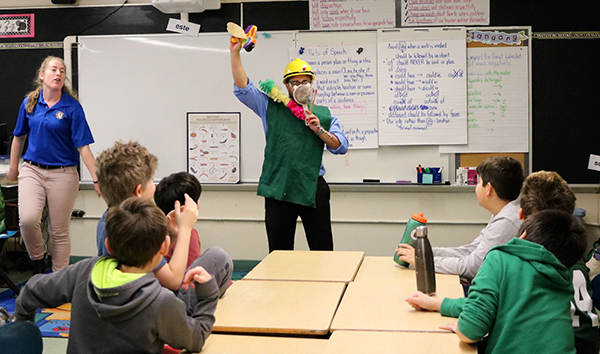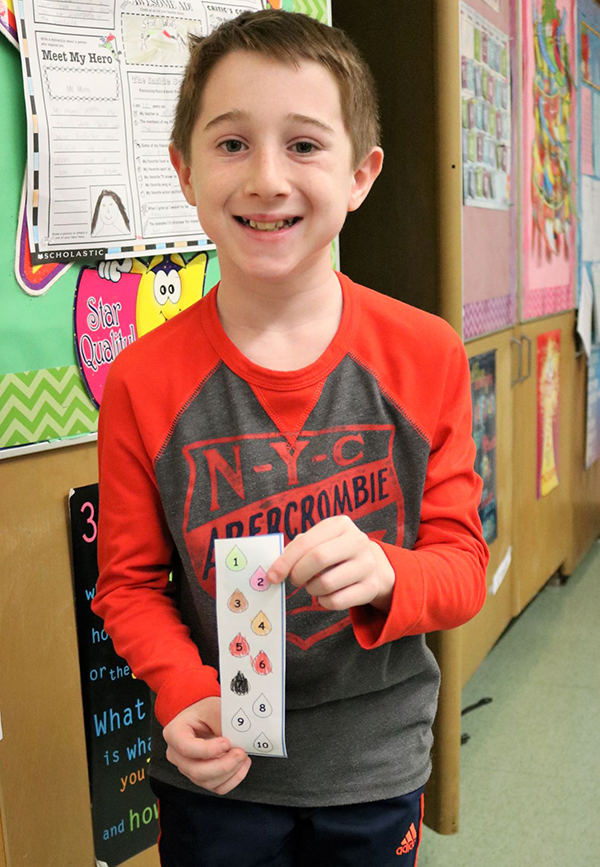
(above) Tamaques 5th grade teacher Victor Alfonso dresses as a macroinvertebrate during a visit from NJDEP “watershed ambassadors.” Different types of these small organisms tolerate different stream conditions and can help to indicate clean or polluted water. Photo credit: Westfield Public Schools.
Tamaques 5th Graders Learn How to Protect New Jersey’s Watersheds
A watershed is an area of land that drains into a body of water such as a river, lake, stream, or bay. There are 5 water regions in New Jersey and 20 watershed management areas. Tamaques 5th graders recently heard from “ambassadors” from the New Jersey Department of Environmental Protection about the importance of watershed stewardship and what can be done to protect the state’s water regions.

(above) During a special visit from NJDEP “watershed ambassadors,” Oliver Dobek (left) and Patrick Greeley examine macroinvertebrates, small organisms found at the bottom of streams that can help determine the health of the water. Photo credit: Westfield Public Schools.
Four members of the AmeriCorps New Jersey Watershed Ambassadors Program visited Tamaques School on January 4, 2019. Fifth graders rotated between hands-on presentations that included taking a close look at how macroinvertebrates help to determine the health of a body of water, following the journey a simple drop of water makes, acting out the varied ways water can be polluted, and becoming Clean Water Rangers as they examined ways they can help to protect New Jersey’s watersheds.
“In social studies, our curriculum looks at global connections. We analyze case studies in different continents, using the five themes of geography. The idea of water as a limited global resource is seen in most, if not all, of the case studies,” says Tamaques 5th grade teacher Victor Alfonso who coordinated this year’s watershed ambassador visit. “Concepts like a watershed, freshwater, ecosystems, food chains, food webs, point and non-point pollution and resource competition are explored.”
Alfonso says these concepts also apply to the fifth grade science curriculum and that there are other connections to be made as well.
“Our Sandy Hook field trip allows us to case study the watershed and ecosystem there,” he says. “And we can find connections with our community garden watershed in front of our school. We learn how important conservation, preservation, and sustainable development are to our community and world.”
“After the watershed presentations, I learned that almost every tiny garbage or waste that goes into the watershed will affect the environment in that area,” says 10-year-old Patrick Greeley. “I learned that it’s up to all of us to do our part, even if it is just one little piece of garbage. Pollution can and must be stopped!”
Ten-year-old Hope Walsh says she found the presentation very beneficial, too. “It taught me that things in everyday life are hurting the watershed including littering, car oil dripping in parking lots, and factories. I now try to not do things that hurt the watershed, including not littering.”
Alfonso says he appreciates the support and collaboration of all who helped to “provide this unique learning experience for the students.”
Photos by Westfield Public Schools

(above) Tamaques 5th grader Leah Abrams becomes a Clean Water Ranger as she and her classmates receive a visit from the NJDEP “watershed ambassadors” on January 4. Photo credit: Westfield Public Schools.

(above) Tamaques 5th grader Lance Alexander holds a bookmark he is creating to follow the journey of a simple drop of water during a special visit from NJDEP “watershed ambassadors.” Photo credit: Westfield Public Schools.
